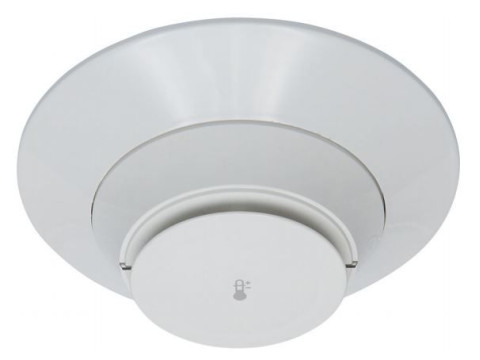Heat fire detectors rank just behind smoke detectors in frequency of use within fire alarm systems. While smoke sensors dominate in many scenarios due to their “universal” detection of combustion particles, heat detectors outperform smoke sensors in certain dusty or smoky environments where optical or ionization detectors might false-trigger. Below, we explore how heat detectors work, focusing on maximum, differential, and linear types, along with best practices for deployment.
Why Use Heat Detectors?
- Dusty, Foggy, or Smoke-Prone Areas: Places like auto-service stations or welding areas create false alarms for smoke sensors. Heat sensors remain stable under these conditions.
- Minimal Maintenance: Less likely to clog or false-trigger.
- High Reliability: Fewer nuisance alarms in harsh conditions.
Key Principle
All heat detectors measure temperature (or its rate of increase) in the zone they protect. When thresholds are exceeded, they trigger an electrical alarm signal to the control panel. In large or specialized spaces, linear heat detection cables help monitor extended distances.
1. Maximum (Fixed-Temperature) Heat Detectors
Maximum heat detectors generate an alarm once ambient temperature reaches a built-in threshold (commonly 50–90°C / ~120–195°F). The exact activation point is factory-set. Some advanced devices can handle higher ranges (up to 200°C / ~390°F).
Early vs. Modern Designs
- Legacy (Non-Restorable): Used a fusible alloy that melted at the trigger temperature, permanently breaking the circuit. Once tripped, these detectors had to be replaced.
- Restorable: Contemporary detectors employ magnetic reed contacts or electronic sensors that revert to normal once the area cools.
Advantages:
- Simplicity & Low Cost: Typically cheaper than other advanced detectors.
- Rugged: Minimally affected by dust or humidity.
Drawbacks:
- Slow Response: Temperature must reach the threshold, so early detection can be delayed.
- May not detect smoldering or slow heat buildup as promptly as other sensors.
Typical Wiring & Compatibility
- Often use “dry contacts” (SPST relay).
- Compatible with both conventional (non-addressable) and addressable fire alarm panels (when a module or interface is used).
2. Differential (Rate-of-Rise) & Combination (Max-Diff)
Differential heat detectors watch how quickly temperature rises. If the rate surpasses a set limit (e.g., 12°F in 1 minute), they trigger. This allows a faster reaction in quickly developing fires. However, if the temperature rises slowly but eventually becomes very high, a purely differential detector may never trigger. That’s where combination (max-diff) detectors come in:
2.1 Differential-Only
- Principle: Typically employs two thermal sensors: one exposed, one insulated. A sudden temperature change causes a noticeable difference between them, activating the alarm.
- Limitation: Slow heat increases might never surpass the rate threshold.
2.2 Maximum-Differential
- “OR” Logic: Alarms when either the fixed threshold is reached or the rate-of-rise trigger is exceeded—whichever comes first.
- Effectiveness: Faster detection compared to purely fixed detectors, plus a backup if the temperature rises gradually.
- Cost: Higher than basic maximum detectors, but often comparable to smoke detectors.
Signaling & Power
- Many max-diff detectors are 2-wire loop-powered, changing current draw in an alarm. Some have separate output contacts.
- The fire panel must support 2-wire detection with loop current monitoring.
3. Linear Heat Detectors
Unlike point (spot) sensors, linear heat detectors extend coverage along cables or tubes—ideal for:
- Tunnels
- Elevator Shafts
- Cable Conduits
- Long or Narrow Spaces
Main Types
Electromechanical (Contact) / Thermocable
- Twisted pair conductors in heat-sensitive insulation.
- Once the temperature surpasses a threshold, insulation melts, causing the wires to short—the control module logs an alarm and can approximate the short’s location.
- Usually non-restorable.
Electronic
- A “multi-point” cable with multiple sensors or an element whose resistance changes with heat.
- Restorable if not physically damaged by extreme heat.
Mechanical (Gas Pressure)
- A sealed tube with gas that expands under heat, raising internal pressure.
- A sensor monitors that pressure, triggering an alarm at a set limit.
Optical (Fiber-Optic)
- Specialized fiber changes light transmission properties when heated.
- Typically employed in advanced or high-value industrial settings; signals processed via a control unit.
Pros & Cons
- Pro: Covering extended distances or difficult spaces where point sensors are impractical.
- Con: Expensive, more complex to install/maintain.
- Alternative: Sometimes an aspirating system is used instead, though it can also be costly.
Installation & Configuration Tips
- Correct Temperature Rating
- Maximum detectors come in different setpoints (e.g., 50–90°C). Choose one matching the ambient environment.
- Mounting Location
- Typically on the ceiling (point detectors).
- For linear cables, run them near the top or along likely heat pathways.
- Avoid direct airflow from vents that might delay actual temperature sensing.
- Zone Coverage
- Align with local fire codes for spacing between detectors (e.g., 30 ft intervals for certain heat detectors).
- Provide extra detectors in large or irregularly shaped rooms.
- Loop Power
- For 2-wire detectors, confirm the control panel supports their current draw.
- Addressable or 4-wire systems might need separate power lines or interface modules.
- Environmental Factors
- Heat detectors excel where dust or steam might hamper smoke detectors.
- Still, extremely cold areas or unheated attics can slow the heat detection process significantly.
Conclusion
Heat fire detectors (maximum, differential, or linear) offer robust solutions in areas hostile to smoke detectors—dusty, steam-filled, or prone to fast flaming. Each variant has unique strengths:
- Maximum: Straightforward, cost-effective, triggers at a set temperature threshold.
- Differential or Max-Diff: Faster detection for rapid temperature increases, with a backup fixed threshold.
- Linear: Covers extended or complex spaces where point sensors are impractical.
Proper selection, correct mounting, and compliance with local fire codes ensure heat sensors effectively complement or replace smoke detectors in specialized environments. For advice on planning or integrating heat detectors into your fire alarm system, visit safsale.com—where our experts can guide you through device selection, installation, and code compliance.

